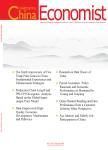Capital and Labor Allocation Structure and China's Economic Growth
Capital and Labor Allocation Structure and China's Economic Growth作者机构:Institute of Economics the Chinese Academy of Social Sciences
出 版 物:《China Economist》 (中国经济学人(英文版))
年 卷 期:2016年第11卷第2期
页 面:64-81页
学科分类:02[经济学] 0201[经济学-理论经济学] 020105[经济学-世界经济] 08[工学] 083304[工学-城乡发展历史与遗产保护规划] 0833[工学-城乡规划学]
基 金:Major public tendering project of the National Social Sciences Fund--Study on Accelerating Economic Restructuring and Promoting Coordinated Economic Development(Grant No.12&ZD084) Project of the National Social Sciences Fund--Study on the Pattern,Evolutionary Mechanism and Sustainable Development of China's Urbanization(Grant No.12AJL009)
主 题:structural effect factor allocation structural deceleration capital stock
摘 要:Using sector-specific growth accounting method, this paper investigates the growth effect of inter-industry allocation of capital and labor in China. This paper has found that existing investment data are classified according to investment entities rather than user entities and directly using such data for the measurement of capital inventory of various sectors will seriously overestimate the capital inventory of tertiary industry and lead to distorted conclusions of structural burden of capital allocation and its serious violation of the principle of efficiency. By excluding real estate sector, this paper has found that after the 1990 s, inter-industry capital allocation had been generally consistent with the principle of efficiency and the effect of capital allocation structure is not significant. Our estimates also found that the growth effect arising from the inter-industry allocation of labor since reform and opening up averages 0.63 percentage points, which is significantly positively correlated with residual economic growth rate and residual TFP and demonstrates a decade-long reform cycle. According to the comparative study on the effect of labor allocation structure of 37 other countries and regions, by 2017, the effect of China s labor allocation structure will continue to remain in a relatively high stage; between 2017 and 2023, structural effect will significantly diminish and deceleration pressure will rise swiftly; after 2030, the effect of labor allocation structure will linger in a low level stage, when economy is likely to enter into a stage of low growth rate. These findings will help us better assess future economic growth tendencies.



